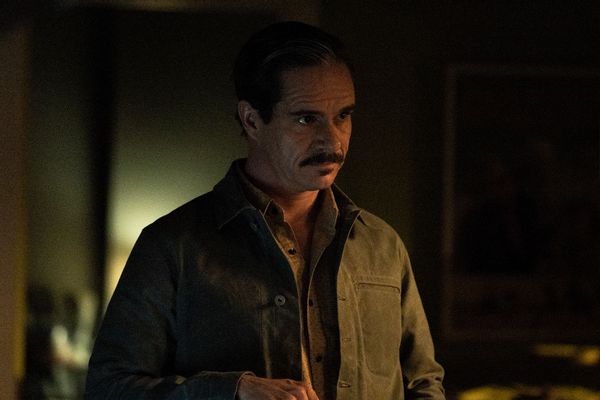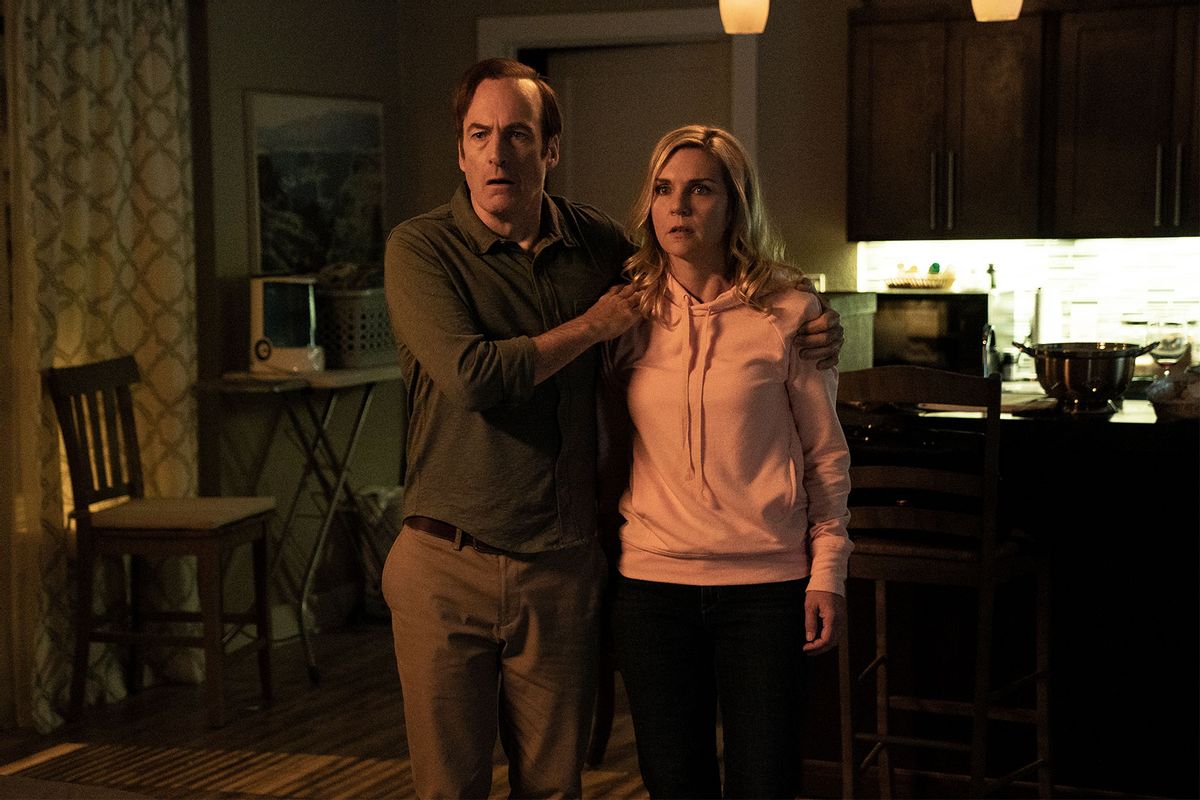As "Better Call Saul" glides toward its series finale, the visual symbolism organizing each episode feels more intentionally obvious than ever. In other shows that might be perceived as negative criticism, but not here. The picture tells the story more honestly than the dialogue whether by way of oblique hints or, as with the opening moments of "Point and Shoot," a wish that a pivotal situation had gone differently.
Series co-creator Vince Gilligan could have picked up the story directly after violent kingpin Lalo (Tony Dalton) murdered upstanding local attorney Howard Hamlin (Patrick Fabian) in Kim (Rhea Seehorn) and Jimmy's (Bob Odenkirk) apartment, shocking them out of their intimate wind-down over wine and a movie.
Instead, as if to ease us back into this increasingly cruel examination of fate and consequences, he opens with a languid sweep across the sand. Nearly every episode of the season opens this way, a motif that also plays through "Breaking Bad," with the camera doubling as both investigator and witness, scanning a scene before landing on an inanimate object that would be meaningless detritus to most people.
But in this show, landscape shots frequently double as warning shots. Earlier in this season, when a camera swept a barren, sandy landscape before diving into the story, it was later revealed to be the site where Nacho was killed. The sandy stretch opening "Point and Shoot" looks equally as desolate until we hear the watery sighs of the sea joining the windy whoosh, letting us know this is the beach, not the desert.
RELATED: On "Better Call Saul," two devils come knocking, but only one leaves
As foamy saltwater drags the shore, we then see a gentleman's shoe, one with broguing on it, bobbing in waves. Its match sits on the dry sand near a Jaguar with the door open, along with a wallet and a wedding ring placed on the dashboard. The license identifies it as Howard's car. If we didn't know what happened to Howard, we might assume this to be evidence of a suicide, enacted in a picturesque setting.
The violence only tells part of the story. The real treasures are placed in each frame.
But the audience knows Howard was murdered, who did it, and whose fault it is that Howard is dead instead of alive and reputationally battered, as Kim and Jimmy intended. There are no seasides in Albuquerque, New Mexico, making the beach a bright postcard fantasy of an ending that, while tragic, would have been a premeditated act, one final exertion of control. The reality is darker and a whole lot messier.
Each episode of this sixth and final season of "Better Call Saul" is named for a pairing or a choice. "Point and Shoot," as Lalo says to a terrified Jimmy and Kim, describes a principle that could apply to both a camera and a gun. The violence only tells part of the story, though. The real treasures are placed in each frame.
Lalo plans to compel Gus Fring (Giancarlo Esposito) out of hiding, and perhaps punish his lawyer by getting him killed, by sending Jimmy up to Gus' home in the middle of the night. He orders Jimmy to knock on the door and gun down Gus when he answers, then take a photo to bring back as evidence. In exchange, Kim would stay back at the apartment, tied up, and upon Jimmy's successful completion of the mission . . . well, Lalo never says what he'll do then.
But everyone in this show thinks like a con artist, looking a few steps ahead and making wagers on human behavior. Jimmy persuades Lalo to send Kim to do the hit instead. At least, Jimmy thinks he's pulled that off. It really doesn't matter which one goes, because Lalo correctly guesses that Gus' men, led by Mike (Jonathan Banks) are guarding his home and stop Kim before she can pull the trigger.
The hitch is in what they don't know about each other. That includes Gus who, as it turns out, was thinking many steps ahead of everyone, including Lalo.
 Tony Dalton as Lalo Salamanca in "Better Call Saul" (Greg Lewis/AMC/Sony Pictures Television)
Tony Dalton as Lalo Salamanca in "Better Call Saul" (Greg Lewis/AMC/Sony Pictures Television)
If we didn't intimately know Gus Fring, his preparedness for Lalo might have come off as a bit too elegant and convenient to be plausible. But in this episode, Gordon Smith writes directly to Gus' awareness of how the grandeur of his goals collides with the cartel's expectations of him – especially Lalo and the other Salamancas. Gus is determined to outwit and outlast everyone in this game.
That means he has been watching everyone, hence his apparent understanding of what must happen. Kim has only been spoken to by Mike until now, which makes Gus' choice to speak to her directly on the phone significant. When he asks Kim how she came to be at his door, Kim tells him that it was supposed to be Jimmy, her husband, but he talked Lalo out of that, allowing her to go in his stead.
"He . . . talked . . . Lalo . . . out of it," Gus repeats, before calling a few of his men to his side and heading to the laundry facility.
Before all of this transpires, Gus removes his tie, that ever-present shield of courtly signaling that affords him something the Salamanca could never obtain without a gun or bloodshed: respect.
Five more episodes remain in "Better Call Saul," requiring Gilligan, his co-creator Peter Gould and their team of writers and directors to resolve a few of lingering questions. Some, as we've noted before, have been answered by the fact of a character's existence in "Breaking Bad."
Others require more extensive shading. It matters, for example, that Kim Wexler isn't present in Saul Goodman's life when he meets Walter White. After this episode, the odds seem greater that Kim survives this chapter.
Besides, spelling out why she isn't with Jimmy in the future is far more compelling to explore. Gilligan and Smith pull into that intersection in "Point and Shoot" by resolving the rivalry between Gus and Lalo once and for all.
Lalo breaks into the laundry facility, perhaps expecting Gus would confront him; he planted the idea that he planned to blow up the place, after all. And he was correct. Gus showed up with a couple of men who Lalo easily dispenses with before he forces Gus to reveal the underground meth lab to him, filming everything to show to Don Eladio.
But Gus always has plans to deal with contingencies, including those within contingencies. This time, he has a gun hidden in a piece of machinery, which he retrieves before exchanging fire with Lalo. They both take a few hits. Gus is wearing a bulletproof vest. Lalo, in his arrogance, would never.
When the shooting stops, Gus walks over to where Lalo lays and stands regally over him as he takes his last breath. Only when he's sure that Lalo is dead does Gus collapse too, revealing he's been wounded in the shootout.
By the time Mike steps in to clean up everyone's messes, it's plain to see that Kim cannot remain alongside Jimmy for much longer, since Saul Goodman's reputational rise requires an acceleration in Jimmy McGill's moral decline. Hurting others at a distance as a "friend of the cartel" is one matter, but getting a colleague-turned-adversary murdered changes everything – especially given that Kim originated the plan to embarrass Howard, not destroy him.
And when Mike sits them down and tells them the plan to get rid of Howard's body, Kim and Jimmy are in such deep shock that they look a tender breeze away from catatonic – until Mike, after stating that Howard's car will be found several states away by the water, the odometer set to the perfect distance, adds that that cocaine will be found in the upholstery.
"That's the story you were setting up for this guy, yeah?" Mike says, explaining they'll call it a suicide. That jolts Jimmy back to the moment. Kim remains dead-eyed.
Then he tells the pair to go about their days as if nothing happened, and when Howard's absence is noted, "You keep telling the lie you've been telling.
"I need to impress upon you: None of this ever happened," Mike finishes. Moments later, Jimmy glimpses the body of his and Kim's former boss, and his brother's partner and friend, being stuffed into their refrigerator. Mike politely replaces it with a lovely stainless steel model.
Want great food writing and recipes? Subscribe to Salon Food's newsletter, The Bite.
We have yet to glimpse Gene Takavic, Jimmy's future self, a Cinnabon manager hiding out in a colorless Nebraska. But in many ways, this entire season has played with the concept of black and white, reminding us through small clues that shades of grey define the world more distinctly than those extremes.
Our view of the movie Jimmy and Kim were enjoying before Howard and Lalo invaded is one such metaphorical hint, Gus' triumph over Lalo is another. Gus' martial preparedness for Lalo's ruse to take down the meth fortress is foretold in the brief credits sequence which, this week, shows a tarantula crawling out from beneath a tie. The entire episode is shot in dim lighting, emphasizing that all of this life-altering moves take place in the dead of night.
Even the blocking of certain scenes has subtle purpose to it, as when Jimmy, gagged and bound to a chair, ends up falling over right by Howard's body, his head to Howard's feet. An overhead shot displays the two men as a yin and yang arrangement – affirmative to negative, big to small, strong to weak – something a guy with a vanity license plate reading "NAMAST3" may have appreciated.
But the truth of where Howard ends up would be unbecoming to any man bound so tightly to his principles as to make him stiff and unbending: Gus' men slide Howard's body into a grave dug in their gigantic meth factory's floor beside Lalo, the blackest of black hats resting for eternity beside a man who lived by and for the law. Lalo killed Howard, and the saddest part is, that's inconsequential next to the knowledge that Gus killed Lalo by his own hand.
"This could have gone down a whole lot different," Mike sternly says to his boss, admonishing him for diverging from Mike's careful plans to keep him safe. At this, Gus fixes his hard stare on Mike and replies, "It could have," knowing that he, Mike, and an audience of witnesses understand that for men like him, this part of the story could only end one way in order to make it into the next.
New episodes of "Better Call Saul" air at 9 p.m. Mondays on AMC.
More stories like this:



Shares